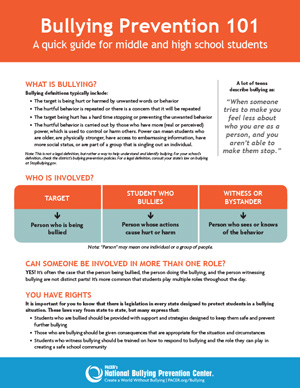In This Section
Bullying Prevention 101 | Quick Guide
A quick guide for middle and high school students.
What is Bullying?
Bullying is typically defined as when:
- The target is being hurt or harmed by unwanted words or behavior
- The hurtful behavior is repeated or there is a concern that it will be repeated
- The target being hurt has a hard time stopping or preventing the unwanted behavior
- The hurtful behavior is carried out by those who have more (real or perceived) power, which is used to control or harm others. Power can mean students who are older, are physically stronger, have access to embarrassing information, have more social status, or are part of a group that is singling out an individual.
Where and When Does Bullying Happen?
Bullying can happen anywhere, anytime. It can occur in your neighborhood, on your way to and from school, at school, and while online.
What is Cyberbullying?
Cyberbullying is bullying – unwanted, repeated, aggressive, negative behavior – that takes place over digital devices like cell phones, tablets, and computers. Cyberbullying can happen over email, through texting, on social media, while gaming, on instant messaging, and through photo sharing.
Who is Involved?
| Target | Person who is being bullied |
| Student who bullies | Person whose actions cause hurt or harm |
| Witness or bystander | Person who sees or knows of the behavior |
Note: “Person” may mean one individual or a group of people.
Can Someone Be Involved In More Than One Role?
YES! It’s often the case that the person being bullied, the person doing the bullying, and the person witnessing bullying are not distinct parts! It’s more common that students play multiple roles throughout the day.
You Have Rights
It is important for you to know that there is legislation in every state designed to protect students in a bullying situation. These laws vary from state to state, but many express that:
- Students who are bullied should be provided with support and strategies designed to keep them safe and prevent further bullying
- Those who are bullying should be given consequences that are appropriate for the situation and circumstances
- Students who witness bullying should be trained on how to respond to bullying and the role they can play in creating a safe school community
What You Can Do If You Are Being Bullied Or See Bullying
If you witness bullying, you have the power to stop it. How? Advocacy skills! Learning advocacy skills can help address bullying for yourself and others.
| Advocacy | Self-advocacy |
| Helping others get what they need | Communicating and taking action to get what you need |
Advocacy skills can empower you to:
- Involve others, especially adults such as parents or teachers
- Gain confidence to take action to stop the bullying and recognize that you have the right to be safe
- Identify what help you need and think of ways you can respond when bullying happens
- Make choices that lead to positive change for you and the bullying situation
If you are being bullied, it’s important to tell someone, especially an adult, you trust. Know that:
- No one ever deserves to be bullied
- You have the right to ask for help to stop the behavior
- Your opinion about what to do is important
- You don’t have to go through the bullying experience alone
If you see bullying, you can:
- Help the person being bullied get away from the situation
- Change the subject when your peers start tearing someone down
- Say something positive about the person being bullied
- Take the direct route and, if you feel safe, ask the person doing the bullying to stop
- Find an adult who can quickly intervene
If you see cyberbullying, you can:
- Write something positive in response
- Contact the person being bullied and let them know you are there for them
- Take a screenshot of the bullying, report it to a parent or an adult at school
- Report the bullying content to the social media platform and ask to have it removed
Student Action Plan
Ready to take action to address bullying?
Bullying can be prevented with students, parents, and educators working together to take action. This plan is an opportunity for you—along with your parents or teachers—to develop a strategy to change what’s happening to you or someone else.
PACER’s Student Action Plan includes three steps:
Step 1: Describe the bullying. Include dates, location, who is involved, and details of the behavior.
Step 2: Describe what you would like done. Think about how the situation could be stopped or prevented.
Step 3: What steps can you take to make that happen? Include who could help, and what they and you can do.
Download the Student Action Plan
